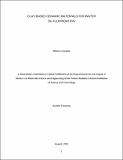Clay-based ceramic materials for water de-fluoridation
Abstract
Long-term consumption of water with fluoride concentration above the WHO recommended
limit of 1.5 mg/g may cause fluorosis. Low-income communities living in fluoride endemic
regions are more affected as they cannot afford well-established water de-fluoridation
technologies. Currently, clay ceramic materials impregnated with silver colloids have been
used to disinfect water disregarding the removal of fluoride. This work investigated improving
the de-fluoridation capacity of clay ceramic materials with in-situ generated Ca/Mg phosphate
system using locally available carbonate rocks as a source of Ca/Mg. To achieve this, clayCa/Mg
phosphate
system
composite
ceramic
materials
were
synthesized
from
varied
ratios
of
clay
(K)
to
carbonate
rock
materials
(R)
(K:R
=
0:100,
90∶10,
85∶15,
75∶25
and
100:0),
sintered
at various temperatures between 500 and 900 . The materials were characterized using
XRF, FTIR, AAS, CHNS-O analyzer and X-ray PDF analysis. The three types of carbonate
rock materials investigated were identified to be; high-calcium limestone, magnesium-deficient
dolomite and near-stoichiometric dolomite. The magnesium-deficient dolomite gave rise to a
Ca/Mg phosphate system that exhibited superior de-fluoridation performance. The material
improved in de-fluoridation performance with increase sintering temperature from 500 to
700 , possibly due to an increase in the more soluble magnesium-substituted tri-calcium
phosphate (β-Mg
x
Ca
3-x
PO
4
), CaO and MgO (PDF and FTIR). This work has shown that the
de-fluorination performance of clay ceramic materials can be improved with a phosphate
system synthesized/formed in-situ using carbonate rocks as Ca/Mg source. The method of
improving the de-fluoridation performance of clay ceramic materials introduced in this present
study has potential applications in the fabrication of water filters with fluoride removal ability.
Collections
The following license files are associated with this item:


